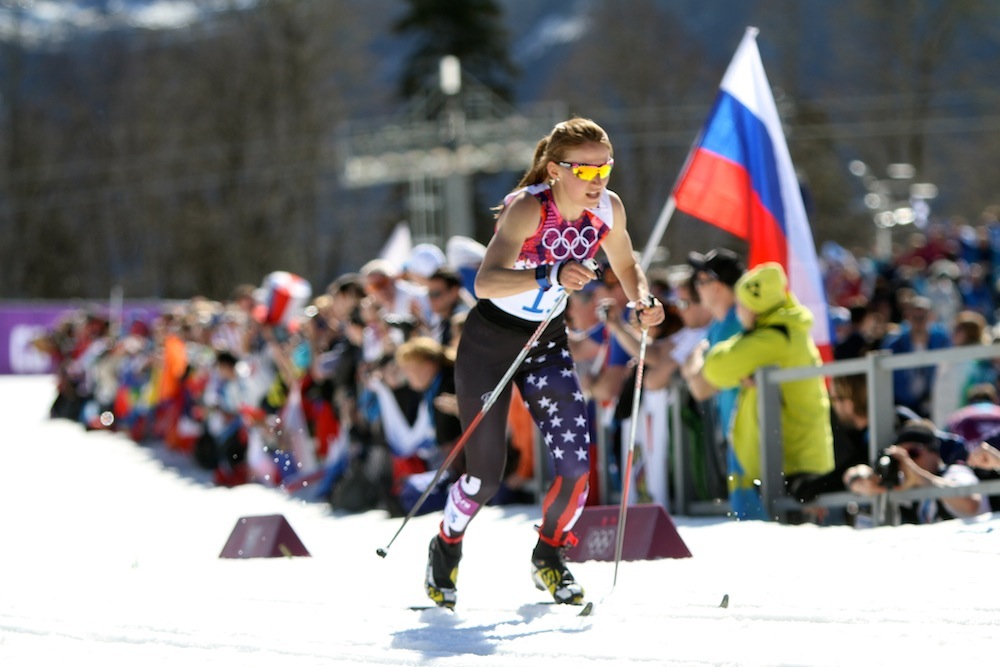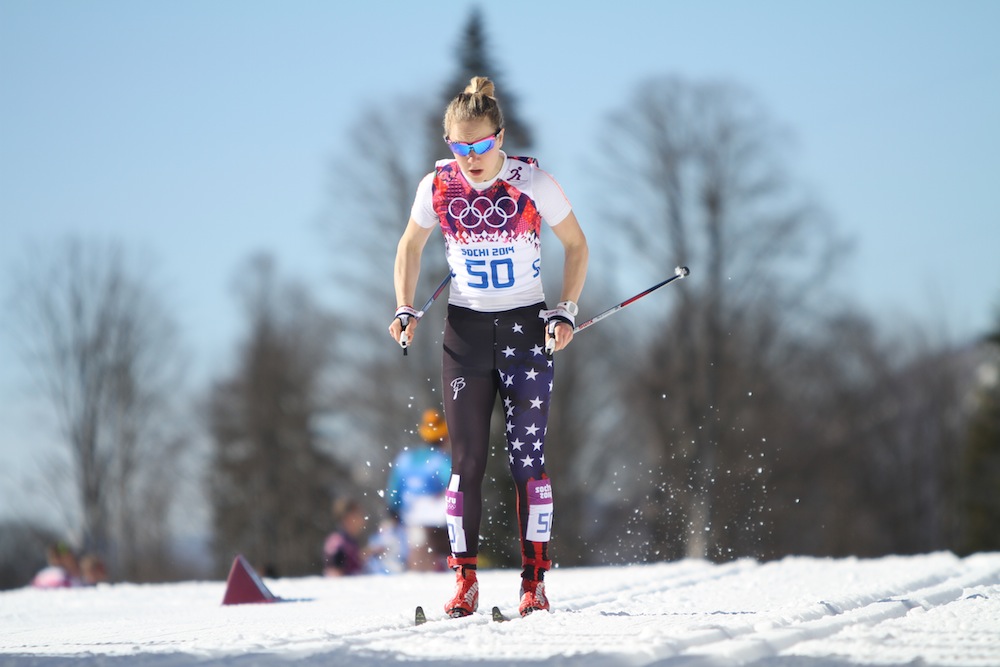
FasterSkier’s coverage is made possible through the generous support of Rudy Project.
SOCHI, Russia – Sadie Bjornsen had a plan for today’s race.
The top-ranked U.S. distance skier entering the 10 k classic, Bjornsen didn’t want to be intimidated by facing the course’s tough hills in the interval-start competition alone.
“The way I was thinking about this race was that every climb has a recovery after it,” she said.
But with temperatures soaring as high as 55 degrees Fahrenheit, racers were faced with a choice: double-pole aggressively down the hills, or tuck and move much slower. Choosing the former meant that when an uphill came back around, they were already tired.
“I quickly learned that was not the case,” Bjornsen said of her plan. “It was going to be a whole 10 k of really pushing. A little different.”
Bjornsen nevertheless adapted and skied a steady race, ranked 16th after 2.2 kilometers before slipping to 18th at the finish, 1:41 behind gold medalist Justyna Kowalczyk of Poland.
It didn’t quite match her seventh-place World Cup finish in the same discipline from Lillehammer, Norway, earlier this season, but Bjornsen pointed out that today’s race was unique in its challenges and required a totally different frame of mind than the others so far this year.
“Today was super fun because it was one of those days where you really had to push your mind and your brain,” she said. “It was warm and soft and just like Eagle glacier. Really challenging courses today. That last kilometer and a half into the finish is sort of where you can make it or break it.”
To stay focused, she tried to ignore anything external and push the pain out of her mind.
“When I got to the bottom and knew that there was a kilometer and a half and it was all up, I just tried to numb my brain and not listen to anything besides the rhythm of pole, pole, pole, pole,” Bjornsen said. “So that’s what I just kept trying to tell myself going up the hill. And then coming over the top you know that every second is places, and so you just try to push it all the way to the finish.”
That was more true than she could have known: Bjornsen finished just 0.3 seconds behind Julia Ivanova of Russia, less than four seconds from the top 15, and 23 seconds from the top ten. Exhausted at the finish, though, she said she couldn’t have gone any faster.
“I was happy with it,” Bjornsen said. “In order to be top 10 today I would have had to have one more gear coming up the hill, but I gave it all I had today, so that was that.”
Americans Push Through Heat, Slush

Bjornsen’s other teammates packed the low 30’s. Sophie Caldwell led the rest of the pack in 32nd, followed closely by Ida Sargent in 34th and Holly Brooks in 35th. All finished within seven seconds of each other and right around three minutes behind Kowalczyk.
“It’s pretty crazy,” Caldwell said of the conditions. “It’s definitely the warmest and softest I’ve skied in in a long time. But our coaches and techs did a great job of keeping it simple, so I was able to stay relaxed through that and it was a relatively seamless process of choosing skis. Which was great. And I had awesome skis. My skis were fast with plenty of kick.”
Sargent agreed, saying she wasn’t quite prepared for the different kind of skiing that the racers encountered today.
“I was having flashbacks to Holmenkollen two or three years ago when it was hot and slow and slushy,” Sargent said. “It’s not how I’ve been classic skiing the last two or three weeks, so it’s a bummer for that to happen today at the Olympics, but that’s what makes ski racing exciting.”
But, as Norway’s Marit Bjørgen later said: it’s the same for everyone, and there probably wasn’t a single person in the field who was excited about such wet, sloppy conditions. Everyone had to make adjustments.
First, they took feeds to stay hydrated.
“I took a feed in the race today, and typically, I would never consider taking a feed in a 10 k,” Brooks said. “But it’s so hot out here.”

Bjornsen, Caldwell, and Sargent all raced in t-shirts or tank tops under their bibs, much to the bemusement of European spectators who weren’t used to seeing bare arms on the race course.
“I warmed up in my race suit, and that was just really hot,” Caldwell said. “Our coaches said that if we felt like it was really hot, we were allowed to go in t-shirts. And it was still really hot! Our race suits are black, so that wasn’t good.”
Brooks, the lone American to go in long sleeves, said she regretted the decision, and might encourage the men to go one step farther tomorrow – like cutting their race suits à la Petter Northug on the final climb of the Tour de Ski.
Jokes and fashion aside, the U.S. women tried to adjust as best they could, slogging their way around the difficult course.
“The second 5k was much tougher,” Brooks said. “You’re tired, you have lactic acid building up in your body, and then this seven-minute climb doesn’t exactly make you feel like a million bucks. The snow is super slow, and at some point people were herringboning on the steep part of the hill, and if someone is doing that in front of you there’s a little power of suggestion, like, okay, that looks good, I’m going to do that too.”
Sargent had a good motivator in Canada’s Dasha Gaiazova, who started 30 seconds in front of her. While Gaiazova had faster skis on the downhill, Sargent was skiing faster on the climbs.
“I’d put some time on her and then she’d gain it back,” Sargent said. “It was a good rabbit and a good thing to keep chasing after, it didn’t let me give up… I just kept fighting, and having Dasha there was definitely helpful.”
It’s safe to say that finishing in the 30’s was not what any of the three were hoping for, but they were cheerful about the day – Brooks said she was looking forward to spectating in the sun for the next few days until her next start in the 30 k.
Sargent said she had to be happy with today’s result, paired with her 189h-place finish in the skate sprint.
“I guess in the back of my mind I was hoping for something a little better, but I think everybody is,” she admitted. “I’m just really happy to be here and excited to be part of team USA. We still have half the week to go so I think our team has a lot of good races to come. It’s really been a fun week so far… I felt like I gave it my all, so that’s all you can ask for in a day. There’s more races to come this year, so hopefully I can get back to where I want to be.”
— Alex Matthews contributed reporting
Chelsea Little
Chelsea Little is FasterSkier's Editor-At-Large. A former racer at Ford Sayre, Dartmouth College and the Craftsbury Green Racing Project, she is a PhD candidate in aquatic ecology in the @Altermatt_lab at Eawag, the Swiss Federal Institute of Aquatic Science and Technology in Zurich, Switzerland. You can follow her on twitter @ChelskiLittle.



